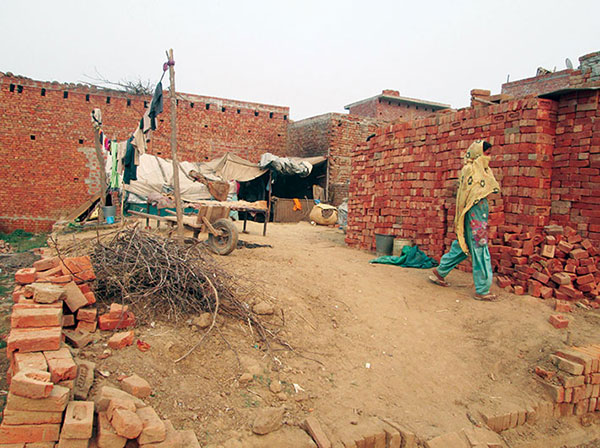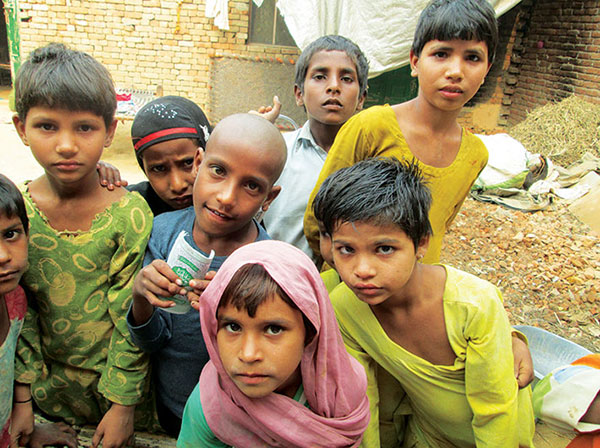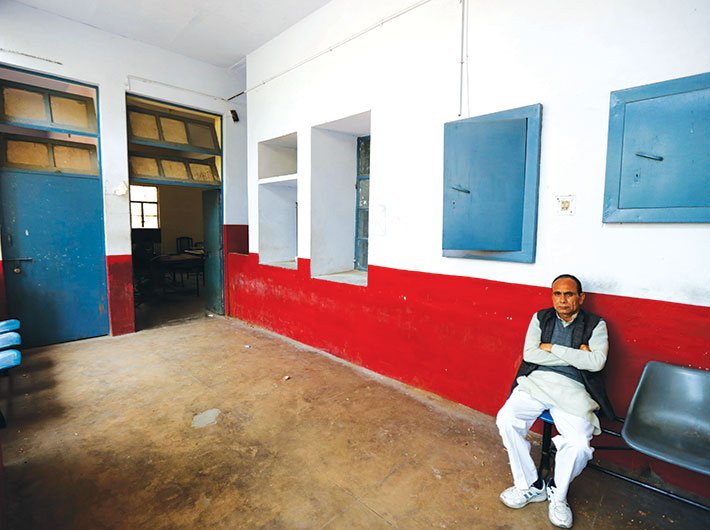A ground report from Muzaffarnagar unravels conspiracy of silence and miscarriage of justice
Dr Akhil Tandon, the chief medical officer at Muzaffarnagar, must have looked grim standing in the witness box of court number 11 of the additional district and sessions judge, and describing the body of 13-year-old Aas Mohammad of Lank village, Shamli district, who had been killed on September 8, 2013.
“The body had an open wound – 4x10 cm size – on the head; 7 cm above the left ear… the body had superficial to deep burn injuries all over; internal organs were burnt beyond recognition… Inside (the body), the right and left parietal (skull) bones were fractured and brain showed congestion and contusion,” reads his statement in the court record.
In fact, two days after Aas Mohammad’s burnt and putrefying body was picked by police from near a village pond, it was brought to the district hospital for Dr Tandon to conduct the autopsy. His report only confirmed what the young boy’s father Iqbal and his grandmother Ramzano had seen: he was attacked with a spear by a neighbour’s son – whom they could identify – and later his body was doused with petrol and set afire.
READ Interview | We, as a society, have failed Muzaffarnagar victims: Jamiat Ulema-e-Hind
“The cause of death is the combination of coma and shock caused by the injuries before death and burn injuries,” the doctor said in his report.
Dr Tandon had also conducted autopsy on Sarajo’s body which was found not far from Aas Mohammad’s.
Sarajo’s and Aas Mohammad’s families had once lived in Lank, 150 km east of Delhi, in western Uttar Pradesh. On the fateful day of September 8, 2013, Sarajo was at her neighbours’ house; telling them that a mob of 25-30 Jat youngsters, who were returning from a Jat panchayat held in Nangla-Mandoud village on the Bijnore road, had entered the village; and how it could be dangerous for the Muslims. Among others, Aas Mohammad’s grandmother Ramzano and his father Iqbal were at home while Sarajo’s husband Wahid was looking over from the terrace of his adjacent mud house.
Suddenly, the mob of some 25-30 men who were brandishing sticks, iron rods, bamboo poles and petrol bottles had barged into Iqbal’s house. He and Wahid could recognise at least ten of their neighbours – whom he later identified in his police report – in the crowd; others were probably the outsiders. Iqbal saw a man – he turned out to be a neighbour – throw a pointed iron rod towards Aas Mohammad. The father heard the boy cry in pain; saw him collapse in the courtyard of his two-room mud house. A few men had, in the meanwhile, dragged Sarajo and Ramzano out of the room. One of them had fired three shots from his pistol at Sarajo, and then someone set her body afire. Someone did the same to the body of Aas Mohammad.
Ramzano was not spared either. The mob also wanted to kill her. They doused her with kerosene and set her afire.
Meanwhile, in the melee Iqbal and Wahid along with other members of their families had managed to flee. Luckily, as soon as the marauding mob had moved away, villagers found Ramzano writhing in pain in the lane. They took her to hospital, and she survived to tell the tale.
The two families have not returned to the village since. Iqbal refuses to meet journalists but he told Governance Now on phone that his neighbours told him the next day that the mob had dragged the bodies of his son and Sarajo to the ‘pond–mosque’ area and waited around till these had burnt to a mass of charred flesh.
Iqbal, like hundreds of Muslims who had fled from their homes in the wake of what is now known as the Muzaffarnagar riots that resulted in death of 60 persons, took shelter in a tent in one of the makeshift settlements set up by the district administration. A few months later, he moved to the house of ‘Haji sahib’ of Kairana village, located about 10 km away from his home on the Haryana border, as a tenant.
Two and a half years later, Iqbal has moved on. With the money he received from the government (Rs10 lakh as compensation after his son’s death) and relief money and material from NGOs he has built a decent house for his family in Kandhla town, 40 km from Muzaffarnagar. Life has changed for him. He no longer has to do odd jobs at the houses and fields of Jat landlords since he is now a grade-four government employee in the court of the city magistrate, Muzaffarnagar. The job is part of the compensation package given by the UP government. Six months ago, a girl child was born to his wife, making Iqbal, once again, a father of four.
Amidst this, when he was called to the witness box of Court No 11 to testify against his son’s alleged killers, who had since been arrested, Iqbal said he no longer recognised them. In fact, he told the judge that he had given his statement to the police (in which he named 10 villagers and 25 others not known to him as part of the mob that killed his son) under pressure and that being in a state of shock, he didn’t know the contents of the signed statement he submitted to the police for filing an FIR.
Iqbal and Wahid had also told the court that they had already fled their homes before Aas and Sarajo were killed – something that was contrary to their initial version.
Ramzano did the same. “I could barely see as I have a poor eyesight,” she told the court.
The court finally declared them ‘hostile witnesses’, and ordered that Iqbal be tried under section 344 CrPC for giving false evidence to police.
Predictably, the ten people accused of murdering Aas Mohammad and Sarajo, were exonerated by additional sessions judge Arvind Kumar Upadhyaya on February 5.
To be fair to him, Iqbal is not alone in giving up the fight for justice. Right in Court No 11, men and women who had earlier identified those involved in serious crimes during riots and were there to testify, have now turned hostile. The four cases in which the accused have walked free after witnesses turned hostile are of gangrape, homicide, loot of property and arson and physical assault – all attributed to the mobs out to kill, rape women and plunder after they had attended the Nagla-Mandoud panchayat where speakers had called for revenge against Muslims.

Ever since the verdict came, Iqbal has chosen to keep himself out of the media glare. He also went incommunicado to a host of NGOs and civil society members, who were shocked at the turn of events at Court No 11 and wanted to contact him.
Iqbal spoke to Governance Now on telephone but refused to meet in person. Speaking from an unidentified place, Aas Mohammad’s father said, “I don’t know why everyone is blaming me for not speaking up in the court. Where were these people when I was living in fear and had to fend for myself and my family?” Though he said he does not wish to pursue the case, the new state-appointed prosecutor has approached the high court against the acquittals.
“Dekho kya hota hai (Let’s see what happens),” he said.
Didn’t he want justice for his son? He replied, “Kya fayda hai? (What is the use of it?)”
Dismayed at the turn of events in the court, Maulana Mahmood Madani, general secretary, Jamiat Ulema-e-Hind, admitted that civil society had failed Iqbal and others in getting justice. “Unlike in Gujarat [riots], the civic society groups were not fully proactive in Muzaffarnagar.”
Sitting in his office in a grandiose Mughal era mosque, which is overshadowed by the concrete skyscraper of the Delhi Police headquarters at Delhi’s busy ITO junction, the Maulana says the Jamiat would fight for justice in Muzaffarnagar riot cases. Read Interview
Maulana Madani’s organisation had so far only campaigned for building inclusive India and never focused on exclusive Muslims issues. In fact, the Jamiat had opposed the creation of Pakistan and held a view that India as a secular state was safer for Muslims. “We have to come out of our shell and fight (in Muzaffarnagar),” he told Governance Now.
Maulana Moosa Qasmi, the Jamiat leader based in Muzaffarnagar, told Governance Now that on Maulana Madani’s instructions, they had already identified 10 of the 300-odd riot-related legal cases which had higher possibility of conviction.
“We will focus on these cases; put together a good legal team and do our best to get justice,” said Qasmi. One of the cases identified by the Jamait is the one involving union minister Sanjiv Baliyan, who allegedly made provocative speeches at the Nangla-Mandaud panchayat triggering widespread riots.
“We are shocked by Iqbal and others turning hostile in a court of law,” Qasmi said. “We had extended financial help to the victims of Muzaffarnagar riots. Iqbal too received our aid. However, not even once did he come here to tell us that he was facing threats which would prevent him from getting justice for his son,” he said.
Ajmal-u-Rehman, president, Muslim Voice of India, a local group which works for welfare of Muslims, said that poor people like Iqbal should not be blamed for not standing up to the socio-economically powerful people. “The victims of the riots are mostly artisans or farm hands who worked for the wealthy landowners, mostly Jats. This social equation has continued for ages.” He says due to the uneven social relations between the two communities, it’s very difficult for a Muslim to stand up in a court of law and point fingers at a Jat while continuing to live in the same neighbourhood.
Here is how things work out on the ground in Muzaffarnagar and surrounding areas of western UP where people are divided over caste and religion. Take the case of Rehana (name changed) of Phugana village. On the day Aas Mohammad was killed, a mob had raided her home. She was cooking in the kitchen and only heard blood-cuddling slogans. Her husband Mustakeen, mother-in-law and other members of the family fled before the mob entered their house. Rehana was trapped inside.

Four of her neighbours, who were out to wreak vengeance against Muslims, had barged in the house. Two of them stood guard at the gate while others took turns to rape Rehana. An hour later, she and other villagers were rescued by police and taken to a camp for riot-affected displaced people at Loi.
She could meet her husband only a few days later, and told him that she was raped. She was devastated as the family now moved to a makeshift camp, and she had no will to fight for justice. However, Vrinda Grover, a supreme court lawyer and women’s rights activist, had reached the camps. Rehana was sitting quietly in the corner of her tent when Grover spotted her.
Rehman recalled, “Vrindaji took her (Rehana) and another rape victim from Phugana to Delhi. She also gave them '25,000 each to buy essentials.” Grover counselled and motivated them to file cases against their rapists. Finally after a gap of 40 days, Rehana went to police to lodge her complaint. The vital evidence, like the rapists’ semen or tell-tale signs of assault, was lost by then.
The alleged rapists of Rehana and Suhana (name changed), from Phugana, were arrested. They were put to trial in the fast-track court.
In the meanwhile, one day a group of youngsters from Phugana came to the Muzaffarnagar police station to complain that Suhana’s husband Naseem was in possession of a pistol and that he had threatened and intimidated them with it. Police summoned Naseem, a washerman by profession, to the station. Some alert members of the civil society groups of Muzaffarnagar came to know about it. Asif Rahi, who heads NGO Paigam-e-Insaniyat, which is engaged in bringing amity between Jats and Muslims, said, “We decided to deal with the issue discreetly. It was clear that the complainants were trying to browbeat the rape victim’s family. He was being framed for his wife’s temerity of approaching the police against Jats and lodging a complaint of rape.” Read Asif Rahi's interview here.
As if felt the move was clearly meant to pressurise Rehana and Suhana to withdraw the cases or change their testimony in the court. “We contacted the administration and told the officers about the real intentions of the complainants. The matter was resolved without it becoming yet another flashpoint for the two communities to fight over,” he said.
However, when time came for Rehana to depose, she told the court that those arrested were not her rapists. Rehana, whose statement was video-graphed (under section 164 of the CrPC) by police, also claimed that she had named the four men as her rapists at the behest of police. Rehana also claimed that she had given her statement to police after she was told that naming them would entitle her to a compensation of '5 lakh. However, during the cross-examination Rehana was asked if the accused had paid for her silence. She said no.
Later, Mustakeen, his mother and others also refused to recognise the four accused, who have since been released for want of credible evidence.
Suhana’s case is still before the trial court.
Rahi and Qazi obviously felt let down by Rehana. “I don’t know how to face Vrinda Grover, who has spent so much time, energy and money in helping the rape victims of riots,” Rahi said. “She even sent her team of lawyers to help us prepare legal cases and did not take a penny for it,” he said.
The verdicts in four Muzaffarnagar riot cases have shocked people across the communities. “Even many Jats are shocked at the turn of events. People are even giving me evidence of how Jats had collected money for saving the accused in the four cases,” he said. Rahi showed us a photocopy of an alleged hand-written list of all-Jat donors. The money, he alleged, was meant to ‘save the Jats’ from going to jails in riot-related cases.
As the accused walked free, an embarrassed Akhilesh Yadav government, which had not bothered to provide security to the witnesses, blamed Sajjad Rana, additional district public prosecutor, for mishandling the riot case and neglecting his responsibilities.
Meanwhile, community sources say the five persons who were found innocent in the four cases, have secured government jobs – three as policemen and one as a teacher.
In the coming days Iqbal would face charges of lying to police; Rehana may come to terms with her trauma; and others may forget the riots, and the killers and criminals will roam free, amidst them.
It seems no one killed Aas Mohammad or Sarajo after all.
aasha@governancenow.com
(The story appears in the April 1-15, 2016 issue)

